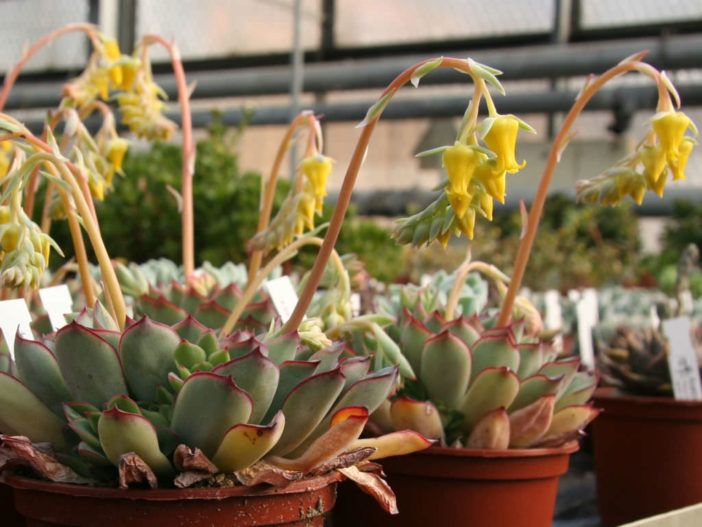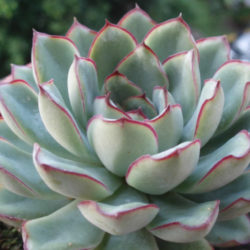Scientific Name
Echeveria pulidonis E.Walther
Common Name(s)
Pulido's Echeveria
Scientific Classification
Family: Crassulaceae
Subfamily: Sempervivoideae
Tribe: Sedeae
Genus: Echeveria
Description
Echeveria pulidonis is a slow-growing succulent that forms stemless rosettes of fleshy, pale green to bluish-green leaves with reddish-brown edges and tips. The rosettes grow up to 3.6 inches (9 cm) in diameter, producing offsets to create a clump over time. Leaves are obovate, flat to slightly concave on the upper surface, and rounded below. They are up to 2 inches (5 cm) long and 0.6 inches (1.5 cm) wide.
The flowers are bright yellow, up to 0.4 inches (1 cm) long, with apically strongly recurved petals, and appear on reddish, unbranched, up to 7.2 inches (18 cm) long stems that bend over their weight in spring.
Origin
Echeveria pulidonis is native to Mexico. It occurs near Beristain in Puebla.
Etymology
The specific epithet "pulidonis (pu-LEE-do-nis)" honors Señor Miguel Pulido, who collected the species in its native habitat.

Hardiness
USDA hardiness zones 9a to 11b: from 20 °F (−6.7 °C) to 50 °F (+10 °C).
How to Grow and Care
Most common Echeveria species are not complicated succulents to grow, provided you follow a few basic rules. First, be careful never to let water sit in the rosette as it can cause rot or fungal diseases that will kill the plant. Additionally, remove dead leaves from the bottom of the plant as it grows. These dead leaves provide a haven for pests, and Echeverias are susceptible to mealy bugs. Finally, as with all succulents, careful watering habits and plenty of light will help ensure success.
Repot as needed, preferably during the warm season. To repot a succulent, ensure the soil is dry before repotting, then gently remove the pot. Knock away the old soil from the roots, removing any rotted or dead roots. Treat any cuts with a fungicide.
Most Echeverias can be easily propagated from leaf cuttings, although a few are better from seeds or stem cuttings. To propagate a leaf cutting, place the individual leaf in potting soil for succulents and cover the dish until the new plant sprouts.
Learn more at How to Grow and Care for Echeveria.
Hybrids
- Echeveria 'Apus'
- Echeveria 'Christmas'
- Echeveria 'Cimette'
- Echeveria 'Hercules'
- Echeveria 'Orion'
- Echeveria agavoides × pulidonis
- ×Graptoveria 'Marpin'
Links
- Back to genus Echeveria
- Succupedia: Browse succulents by Scientific Name, Common Name, Genus, Family, USDA Hardiness Zone, Origin, or cacti by Genus
Photo Gallery
Click on a photo to see a larger version.



